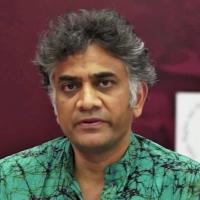
An exhibition of photographs by Asha Thadani at the India Habitat Centre might be the most substantial artwork you will ever see about India and Indians.
This remarkable series, titled ‘Broken’, is as much a work of ethnography as it is art. It shows ten Dalit communities across India. These are the mineworkers in the coalfields of Jharkhand; the boatmen and divers in the Ganga; the Joginis of Andhra Pradesh and Telangana; the Ramnamis of Chhattisgarh; the Holeyas spread across South India, who prepare goat skulls for the extraction of brains; the Theyyam artists of Kerala; the Musahars of Bihar; the Paraiyar mourners of Tamil Nadu; the Dusadhs or Paswans of Bihar; and the Navayan Buddhists.
The portraits are captured through a lens which is at once revealing, sympathetic and Thadani’s work is troubling and captivating at the same time.
Asha Thadani, nominated for the Henri Cartier-Bresson Award in 2015, is one of our most gifted artists. Her hope in this project, as she says in the opening, is ’that it opens at least one door for a closed mind’.
Often work that chooses to look away from the malls, the big weddings and the stock market and its billionaires. One is reminded of Gandhi’s memorable phrase in attacking Katharine Mayo’s book Mother India. This is not an accusation that can be levelled against the present work. It is searing and will leave an imprint on those who see it instantly.

Asha Thadani
This is what the artist achieves here by examining the lives of Indians and the traditions they live in and have been compelled to live in for decades if not centuries and sometimes millennia.
She also shows that though trapped, the individuals she introduces us to are not unaware of their shackles and give us a glimpse into their defiance and their spirit.
‘Broken’ is on exhibition until January 7, 2024 at the India Habitat Centre’s centre atrium.
§

Coal miners including this child, work 17-18 hour shifts in the pits of Jharia. Over 4 lakh of them labour to produce the fuel that powers this nation. Photo: Asha Thadani

The Mallah are boatmen, fishermen and also recoverers of abandoned corpses that are disposed of in the river that Hindus consider their most sacred, the Ganga. Photo: Asha Thadani

The Joginis of Andhra Pradesh and Telangana are born into a life of ritualised sexual slavery. They are forced to live outside the village but exploited in the most direct fashion by a society which sees them with both lust and contempt. Photo: Asha Thadani

Prevented by dominant castes from entering temples, the Ramnamis have brought god to their body: at once an act of religious devotion and social defiance. Photo: Asha Thadani

Even butchers have a hierarchy in India and at the bottom are those who make it possible to retrieve the brains of goats by burning the skulls of fur and hair but are prevented from entering the slaughterhouses they help keep running. Photo: Asha Thadani

Practitioners of one the most moving and intense art forms of India, Kerala’s Theyyam artistes bring divinity to their body and are accepted as having done so — so long as the performance lasts. Photo: Asha Thadani

Rat eaters sound less acceptable than rat catchers, which is how, incorrectly, the term Musahar (eaters of rats) is usually rendered into English. But some of these exploited have found avenues to reinvent themselves. Photo: Asha Thadani

Professional mourners are found in communities across India. Personal association with death, a bad omen for the rest, is imposed on these women who must grieve for others. Photo: Asha Thadani

The Dusadh women adorn their bodies with virtual trinkets and ornaments that they are denied in real life by caste. Like the Ramnamis, they wear their defiance of the norms imposed on them. Photo: Asha Thadani

The great Dr Babasaheb Ambedkar showed Indians the way to keep faith in the divine truth but reject the trappings of religion and dogma. The Navayan Buddhists walk in his footsteps. Photo: Asha Thadani
Aakar Patel is a senior journalist and columnist.






